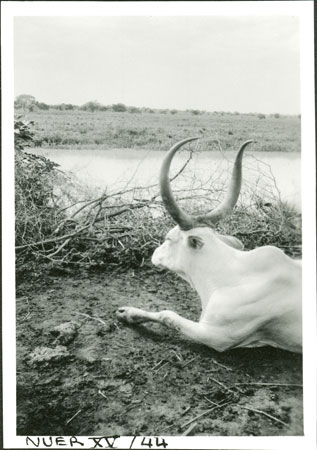Nuer cow

84 x 57 mm (3.25 x 2.25 inch) | Print gelatin silver
There are records relating to alternative images that we do not have scans for in the database:
1998.355.722.1 - Negative film nitrate , (84 x 57 mm (3.25 x 2.25 inch))
1998.355.722.1 - Negative film nitrate , (84 x 57 mm (3.25 x 2.25 inch))
Date of Print:
Unknown
Previous PRM Number:
EP.N.XV.44
Previous Other Number:
22 (230)
Accession Number:
1998.355.722.2
Description:
A portrait of an impressive white cow lying on the ground with large upward curving horns (known as wer), with the Akobo River visible adjacent to the kraal.
It is likely that this photo was taken in May 1935 after Evans-Pritchard had completed a survey of the Anuak.
Photographer:
Edward Evan Evans-Pritchard
Date of Photo:
1935 May
Region:
[Southern Sudan] Jonglei Akobo
Group:
Nuer Lou
PRM Source:
Edward Evan Evans-Pritchard
Acquired:
Donated 1966
Other Owners:
E. E. Evans-Pritchard Collection
Class:
Animal Husbandry , Topography
Keyword:
Animal Cattle , Rivers & Streams
Documentation:
Original catalogue lists in Manuscript Collections. Additional material in related documents files. [CM 27/9/2005]
Primary Documentation:
Accession Book Entry [p.
98] 1966.27 [1 - 24] G[ift] PROFESSOR E.
E.
EVANS-PRITCHARD; INST.
OF SOCIAL ANTHROPOLOGY, 51 BANBURY RD.
OXFORD 1966.27.1-16 S.
SUDAN.
NUER TRIBE.
Sixteen negative albums containing negatives
and
prints of photographs taken by donor during field-work.
All listed in albums.
Added Accession Book Entry - [p.
98 in right hand column, in pencil] Catalogue room.
Manual Catalogues [index taken from album book XV, ms ink] - 44. ox
Note on print reverse ms pencil - "22 230 Akobo [female symbol] wer boora" & print front border ms ink - "NUER XV/44"
Manual Catalogues [index taken from album book XV, ms ink] - 44. ox
Note on print reverse ms pencil - "22 230 Akobo [female symbol] wer boora" & print front border ms ink - "NUER XV/44"
Other Information:
In Nuer Religion (Oxford University Press 1974 [1957] 4), E.
E.
Evans-Pritchard notes that 'an ox of the kind called wer, which has wide spreading horns and is the most majestic of their beasts.' [Chris Morton 1/9/2004]
Recorder:
Christopher Morton [1/9/2004] [Southern Sudan Project]

